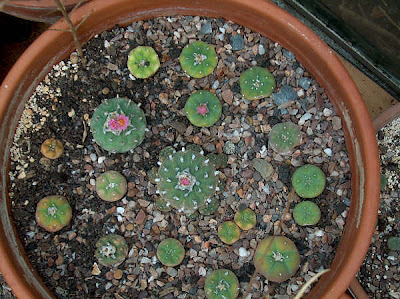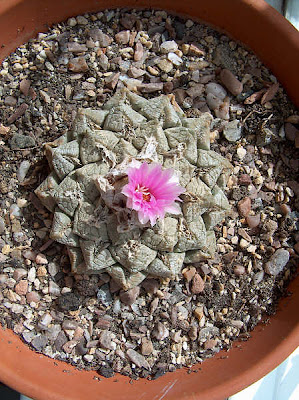Some time ago Rory contacted me to discuss cacti and mycorrhizal associations (an interesting subject that might be brought up in a later post). During our conversations Rory revealed himself as an avid Lophophora grower with an impressive collection of mature and well-grown plants. Rory has kindly allowed me to share some pictures of his plants.
Flowering Lophophora williamsii, close-up
Large pot of Lophophora williamsii
The largest of the L. williamsii plants in this pot are approximately 25 years old. One of the plants in the central group (a bit above and to the left of the center) has been decapitated and set 4 offshoots. One of these has not yet developed a central growing point and appears somewhat cristate, but Rory expects it to develop as normal with time. The removed top was rooted and is also growing in the central group of plants (slightly below center; wool removed from areoles), and is flowering regularly.
Large pot of Lophophora fricii
According to Rory the compost used for the L. fricii plants are not drying fast enough. Consequently the plants are kept on the dry side which accounts for the red coloration shown by some of them. The largest of the plants (with a total of 9 offsets) has only grown 1cm (~0.4'') in the past 9 years so Rory is planning on repotting the plants in a new mix and expects this to speed up growth.
Lophophora diffusa about to flower
The above L. echinata diffusa plant is just about to flower - unfortunately it’s too overcast for the flowers to open properly.
Large pot of Lophophora williamsii v .caespitosa
To top things off (or just to make me completely envious ;-) Rory also threw in a photo of a nice, mature Ariocarpus fissuratus specimen.
Flowering Ariocarpus fissuratus
I hope you enjoyed this “guest appearance” - I for one would like to see more of Rory’s plants. If you have pictures or information you would like to share, you can drop me a mail at “lophophora [dot] blog [at] gmail [dot] com”.
Wednesday, July 04, 2007
Rory’s Lophophora collection
A visit to Myriad Botanical Gardens and Crystal Bridge Tropical Conservatory, Oklahoma City
I recently visited Oklahoma City and had a Sunday to kill. Being within walking distance from my hotel I decided to visit the Myriad Botanical Gardens and Crystal Bridge Tropical Conservatory.
The garden functions as an urban oasis in downtown Oklahoma City with its verdant hills, perennial gardens, and a tranquil lake with koi and lots of turtles sunning themselves. The cylindrical glass shape of the Crystal Bridge Conservatory is hovering above the waters of the lake connecting its shores - a novel and interesting approach to greenhouse construction.

Crystal Bridge Conservatory
While the garden itself and the special architecture of the conservatory merit a visit I was a bit disappointed with the collection of plants kept in the conservatory. The succulent collection (growing on the so-called Dry Mountain) seems like a mishmash of unrelated and mostly unnamed plants (one of the named exceptions being a large Astrophytum ornatum (Monk's Hood)), but I'm probably heavily prejudiced by my expectations to botanical gardens as collections of plants with a scientific scope - not just a look-and-feel-good assemblage of greenery.

Astrophytum ornatum – one of the few named plants

View of the Dry Mountain
Writing this I realized that I've been consistently complaining about the quality of the cactus collections in my posts on botanical gardens – I guess I'll have to arrange a visit to the Desert Botanical Garden (Phoenix, Arizona) in order to see some real plants ;-)
All Time Most Popular Posts
-
Lophophora williamsii (peyote) populations have diminished in large areas of South Texas where peyoteros harvest the cactus for ceremonial ...
-
On various occasions I've been asked what growing media I'm using for my cactus plants. I don't have a set soil mix recipe as su...
-
Below is a list of retailers/nurseries selling cactus seed and plants. I've only listed vendors I've done business with. If you ar...
-
Most cacti are easily grown from seed - and with a little patience and care they can be grown into beautiful plants. Lophophora williamsi...
-
In last month’s post on the troubled Texan peyoteros I referred to Anderson’s article on the peyote situation in Texas. Given the importanc...
-
Yet another slightly off topic and probably not entirely politically correct post, but I couldn’t help noticing the similarity of my monstr...
-
Flowering stand of San Pedro cacti (Trichocereus pachanoi) To me the main draw of the San Pedro cactus ( Trichocereus pachanoi (syn. Ech...
-
In the June 2008 issue of the Cactus & Co magazine Jaroslav Šnicer, Jaroslav Bohata, and Vojtěch Myšák described a new Lophophora spec...
-
There seems to be an increased focus on the alarming Texas peyote situation. A couple of weeks ago the Houston Press published a mournful, i...
-
I spent two weeks working in Delhi, India during January. I had one weekend off and had planned to spend it in Delhi at my own leisure, but ...
























